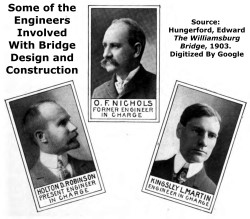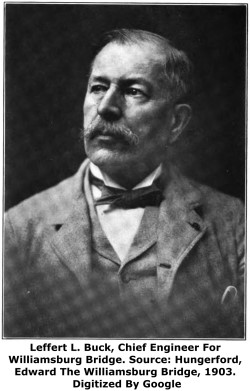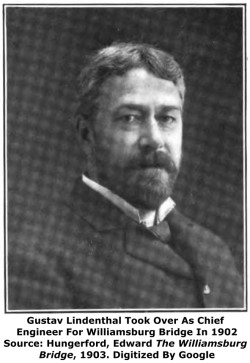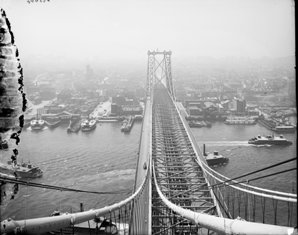We Recommend:
Bach Steel - Experts at historic truss bridge restoration.
BridgeHunter.com Phase 1 is released to the public! - Visit Now
Williamsburg Bridge

Primary Photographer(s): Nathan Holth and Rick McOmber
Bridge Documented: July 12, 2008 and September 3, 2019
New York: Brooklyn, New York and Manhattan, New York: United States
Metal Through Truss Stiffening Wire Cable Suspension, Fixed and Approach Spans: Metal Rivet-Connected Lattice (Quadruple Warren) Through Truss, Fixed
1903 By Builder/Contractor: American Bridge Company of New York, New York and Engineer/Design: Leffert L. Buck
2002
1,600.0 Feet (487.7 Meters)
7,308.0 Feet (2227.5 Meters)
76 Feet (23.16 Meters)
1 Main Span(s) and 53 Approach Span(s)
2240039

View Information About HSR Ratings
Bridge Documentation
This bridge is the second oldest of the East River suspension bridges, and its construction began several years after the Brooklyn Bridge, the oldest of the three, was completed. The bridge is also the longest of the three East River suspension bridges. As a c. 1900 suspension bridge it is an early example of a very large suspension bridge span and is thus considered nationally significant. The bridge's stiffening truss is also significant, as an example of an uncommon truss configuration, the lattice truss. The lattice truss is a complex and aesthetically pleasing configuration that in engineering terms consists of multiple Warren trusses superimposed upon one another.
This bridge is a nationally significant historic bridge whose significance and importance is perhaps underrated simply because it happens to be near the Brooklyn and Manhattan Bridges. This combined, with New York City's fair weather historic bridge preservation commitment actually resulted in a serious consideration to demolish this bridge as recently as 1988! A further lack of concern or awareness for the historic value of the Williamsburg Bridge is evidenced in one of the most distasteful railing/fencing systems ever seen on a historic bridge. The original sidewalk railings (an attractive lattice design) were apparently destroyed to make way for an ugly, massive system of fencing that is painted bright red in striking opposition to the brown paint color of the bridge superstructure. This alteration has destroyed the original pedestrian lattice railings on this bridge. The original railings could have and should have been left on the bridge, even if behind the current modern system of fencing. Furthermore, the massive railings obstruct the view of the historic bridge superstructure, as well as the river. Finally the bright red paint color means that these modern alterations tend to show up in photos where a brown or grey paint color would have helped hide them and allow the historic bridge superstructure to be the focus in photos.
View Archived National Bridge Inventory Report - Has Additional Details and Evaluation
View Historic American Engineering Record (HAER) Documentation For This Bridge
HAER Data Pages, PDF
View A Historical Text About The Williamsburg Bridge
Above: This excellent historical photo clearly shows how the wire cables of the suspension bridge tie into the eyebars at the anchorages. Source: Hungerford, Edward The Williamsburg Bridge, 1903. Digitized By Google.
Above: Views showing tower construction. Source: Hungerford, Edward The Williamsburg Bridge, 1903. Digitized By Google.
Above: The American Bridge Company promoted its work on the towers and approaches for this bridge in advertising of the period. This may be because the Williamsburg Bridge was one of the largest bridges to date that the newly formed company worked on.
Above Left: Photo showing construction of bridge. Above Right: Historical photo taken from top of tower. Source: Library of Congress.
Above: An advertisement for John Roebling Sons company featuring the Williamsburg Bridge indicates that the company did the cable work for the Williamsburg Bridge. The advertisement photo shows where the cables tie into eyebars which lead into the anchorage.
![]()
Photo Galleries and Videos: Williamsburg Bridge
Bridge Photo-Documentation
Original / Full Size PhotosA collection of overview and detail photos. This gallery offers photos in the highest available resolution and file size in a touch-friendly popup viewer.
Alternatively, Browse Without Using Viewer
![]()
Bridge Photo-Documentation
Mobile Optimized PhotosA collection of overview and detail photos. This gallery features data-friendly, fast-loading photos in a touch-friendly popup viewer.
Alternatively, Browse Without Using Viewer
![]()
Historical Bridge Opening
Full Motion VideoFrom the Library of Congress archives,a historical video showing the bridge being opened following the completion of construction. The film was shot on the roadway of the newly constructed Williamsburg Bridge. The first people to come into view are press photographers carrying large wooden box cameras -Frame 0690-. Next, a parade of dignitaries and military representatives, accompanied by members of the press -1310-, is photographed passing the camera position led by a standard bearer whose banner reads MAYOR in FRAME -0902-. The mayor of New York was Seth Low, a lame-duck at the time of filming, having been defeated in November, 1903 by George B. McClellan. Streaming video of the bridge. Also includes a higher quality downloadable video for greater clarity or offline viewing.
![]()
Maps and Links: Williamsburg Bridge
Coordinates (Latitude, Longitude):
Search For Additional Bridge Listings:
Bridgehunter.com: View listed bridges within 0.5 miles (0.8 kilometers) of this bridge.
Bridgehunter.com: View listed bridges within 10 miles (16 kilometers) of this bridge.
Additional Maps:
Google Streetview (If Available)
GeoHack (Additional Links and Coordinates)
Apple Maps (Via DuckDuckGo Search)
Apple Maps (Apple devices only)
Android: Open Location In Your Map or GPS App
Flickr Gallery (Find Nearby Photos)
Wikimedia Commons (Find Nearby Photos)
Directions Via Sygic For Android
Directions Via Sygic For iOS and Android Dolphin Browser
USGS National Map (United States Only)
Historical USGS Topo Maps (United States Only)
Historic Aerials (United States Only)
CalTopo Maps (United States Only)















